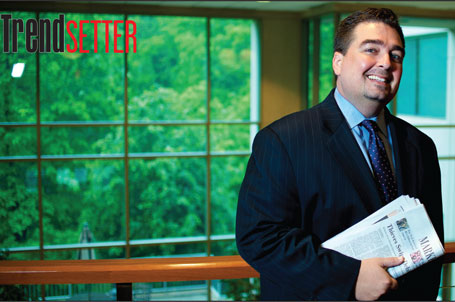As President of Dudynk, a full-service healthcare advertising agency, Frank X. Powers implemented what some might consider a mad plan for running an ad agency: Focus on a strong corporate culture and actualized, happy employees. Crazy idea, right? Frank believes that happy employees lead to happy clients, and that it pays to have a laser-focused approach as it will attract talented people and prospective clients. It just so happens that his plan is working. Dudnyk continues to grow steadily each year and in 2011 it was named to the Inc. 5,000 list of fastest-growing privately held companies. Frank took the time to chat with PM360 about his management style for his agency as well as for brands.
PM360: How does managing an advertising agency differ in today’s current environment from a year ago?
Frank X. Powers:
The proliferation of mobile has certainly changed the way we build, create and deliver promotional materials. But the guiding principles of our agency are very much the same. Understand the science, gain a thorough knowledge of the marketplace, set a strategy that allows a product to be differentiated, and execute a stunning creative campaign that garners mind and market share. I will also say that the role of the patient has increased dramatically for each of our clients during the past year.
It has become more important for our client base to thoroughly understand how patients access information and the relationship between specialty physicians and their patients.
What do companies need to know about managing pharma, biotech and medical device product brand identities?
The one thing companies should be most aware of is that a brand identity is now a living, dynamic entity—and not always under the company’s control. It needs to be created in a specific time and space, and then it needs to be cultivated and managed organically in response to its environment. This used to be called brand management, implying a specific set of actions to follow during a specific timeframe. In the past five years, however, managing the life of a brand identity has turned into a whole different animal—one of managing the brand experience.
The methods by which the professional target audience has traditionally engaged in that brand management experience—rep access, medical journals, detail aids, conventions, brand awareness reminders—are now just the cost of entry. Today, more than ever, it is all about the overall brand experience. The main thing these companies need to know is that the rules on how to manage brands are being rewritten even as we speak. Social media and mobile have completely raised the level of knowledge it takes to effectively manage a brand experience and opened up thousands of new possibilities for a brand interaction. Some of these experiences are good, while others are not. The important thing is to work with a brand partner to help manage these new possibilities. If you don’t consistently manage the new brand experience, the marketplace will manage it for you.
How do you work with your clients when planning a positioning/messaging strategy?
At Dudnyk, we begin by developing a positioning strategy, not a message or a statement, during a workshop to build consensus on the strategy. And by workshop, I don’t mean some squishy feel good day with marketing and the agency. This has to be open, transparent, realistic, and involve the major decision-makers from sales, marketing and commercial operations. You would be amazed at what can happen during a workshop when the commercial team believes everyone is on the same page as far as strategy and position. Consensus isn’t easy, or comfortable to achieve, but the lack of it is often at the heart of why commercial teams don’t succeed.
How can companies improve the success of a product’s development and launch?
Several keys exist to improving product development: Understand the unmet need, the barriers to entry and the current practice from all the stakeholders’ perspectives (healthcare professionals, patients and managed markets). Involve the brand team and agency as early as possible in the development process so that clinical trials can be designed with the brand vision in mind. That means that the brand vision needs to be figured out early in the process and targeted product profiles need to be developed and tested with target customers. This can be tricky with small specialty pharmaceutical companies developing therapies for rare disorders as they typically have small staffs made up mostly of scientists and a CFO who may be making decisions regarding brand name, logo design and preliminary branding. These companies generally don’t bring on marketing personnel until the product is in phase III.
The overarching goal of any brand launch is rapid uptake. That means that physicians need to understand the brand’s promise immediately to see how a brand fits into their practice. If you’ve done all of the commercialization work properly, this becomes much easier, but it is not a guarantee. Coordination of all promotional materials is essential to a successful launch and extending the reach of the sales organization via non-personal promotion is becoming standard, especially among specialty pharmaceutical organizations, which typically have smaller sales forces. We’ve helped a number of our clients through this process by managing many of the details associated with launch, allowing them to focus on issues such as product supply and distribution.
You have said that, “success lies in taking care of an agency’s people—its employees and loyal clients,” can you tell me what has led you to this perspective on managing your agency?
Each night our agency’s greatest assets walk out the door. It’s my job to ensure that when they come to work each morning, they have the tools, resources and training necessary to do a better job than the day before. Our employees and our clients both have significant tenure with Dudnyk, so it is important for both parties to see that investment is being made in the people, the relationship and the brand. The tenure and loyalty of our staff and clients becomes the foundation for amazing work, because there is already a track record of moving the market via compelling creative thinking. Once you achieve that level of success with a client, they want to reproduce that success again and again.
What has been your greatest success and your greatest disappointment?
Being named recently as a 2012 Top Workplace in Philadelphia by the Philadelphia Inquirer and as one of the Inc. 5,000 fastest-growing privately held organizations, there has been quite a bit of great news to be proud of. However, contributing to building an organization with a culture of innovation, creativity and success, along with the ability to give back to the community has been my greatest success.
Regarding my greatest disappointment, I would have to say watching our industry lose the ability to consistently produce outstanding creative. We have some of the best minds in advertising focusing on healthcare challenges; therefore, the creative bar should be much higher than it currently is. That is why amazing healthcare creative should be celebrated and recognized, but it is sad that strong work is the exception, not the rule.







